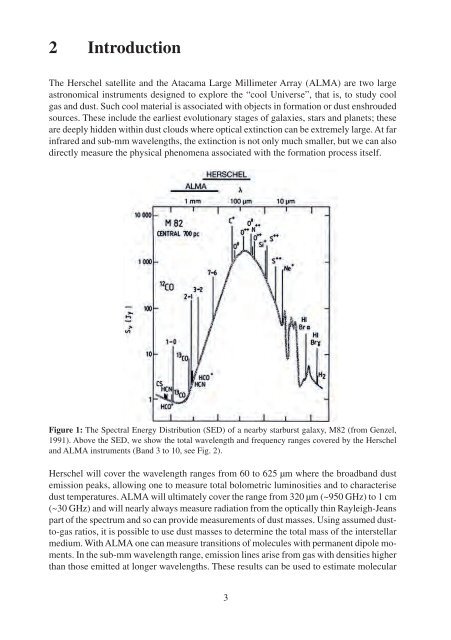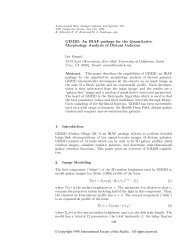4 Comparison of the ALMA and Herschel - ESO
4 Comparison of the ALMA and Herschel - ESO
4 Comparison of the ALMA and Herschel - ESO
You also want an ePaper? Increase the reach of your titles
YUMPU automatically turns print PDFs into web optimized ePapers that Google loves.
2 Introduction<br />
The <strong>Herschel</strong> satellite <strong>and</strong> <strong>the</strong> Atacama Large Millimeter Array (<strong>ALMA</strong>) are two large<br />
astronomical instruments designed to explore <strong>the</strong> “cool Universe”, that is, to study cool<br />
gas <strong>and</strong> dust. Such cool material is associated with objects in formation or dust enshrouded<br />
sources. These include <strong>the</strong> earliest evolutionary stages <strong>of</strong> galaxies, stars <strong>and</strong> planets; <strong>the</strong>se<br />
are deeply hidden within dust clouds where optical extinction can be extremely large. At far<br />
infrared <strong>and</strong> sub-mm wavelengths, <strong>the</strong> extinction is not only much smaller, but we can also<br />
directly measure <strong>the</strong> physical phenomena associated with <strong>the</strong> formation process itself.<br />
Figure 1: The Spectral Energy Distribution (SED) <strong>of</strong> a nearby starburst galaxy, M82 (from Genzel,<br />
1991). Above <strong>the</strong> SED, we show <strong>the</strong> total wavelength <strong>and</strong> frequency ranges covered by <strong>the</strong> <strong>Herschel</strong><br />
<strong>and</strong> <strong>ALMA</strong> instruments (B<strong>and</strong> 3 to 10, see Fig. 2).<br />
<strong>Herschel</strong> will cover <strong>the</strong> wavelength ranges from 60 to 625 µm where <strong>the</strong> broadb<strong>and</strong> dust<br />
emission peaks, allowing one to measure total bolometric luminosities <strong>and</strong> to characterise<br />
dust temperatures. <strong>ALMA</strong> will ultimately cover <strong>the</strong> range from 320 µm (~950 GHz) to 1 cm<br />
(~30 GHz) <strong>and</strong> will nearly always measure radiation from <strong>the</strong> optically thin Rayleigh-Jeans<br />
part <strong>of</strong> <strong>the</strong> spectrum <strong>and</strong> so can provide measurements <strong>of</strong> dust masses. Using assumed dustto-gas<br />
ratios, it is possible to use dust masses to determine <strong>the</strong> total mass <strong>of</strong> <strong>the</strong> interstellar<br />
medium. With <strong>ALMA</strong> one can measure transitions <strong>of</strong> molecules with permanent dipole moments.<br />
In <strong>the</strong> sub-mm wavelength range, emission lines arise from gas with densities higher<br />
than those emitted at longer wavelengths. These results can be used to estimate molecular<br />
3




